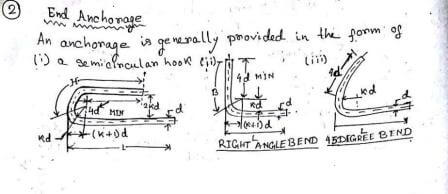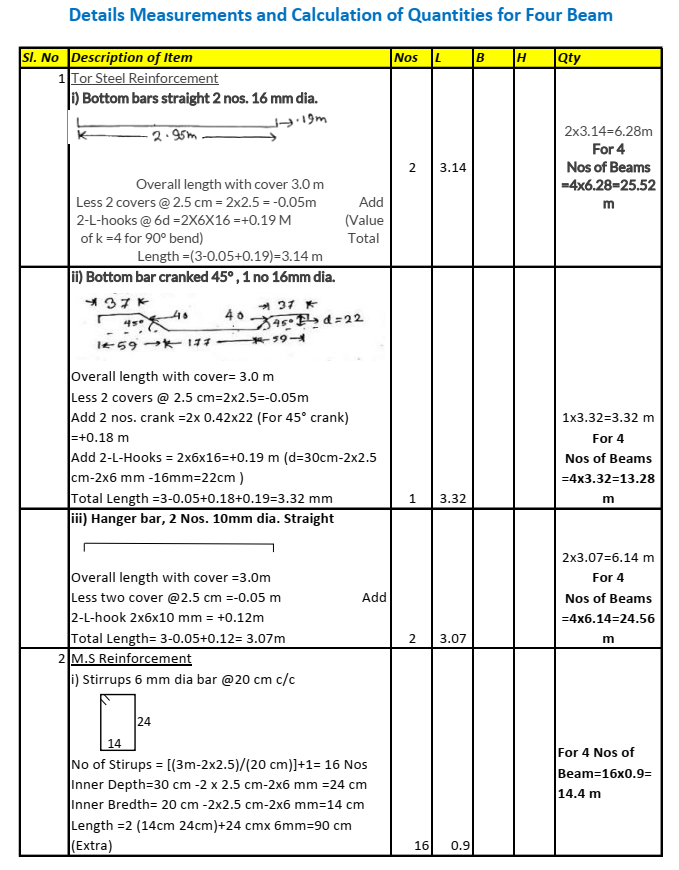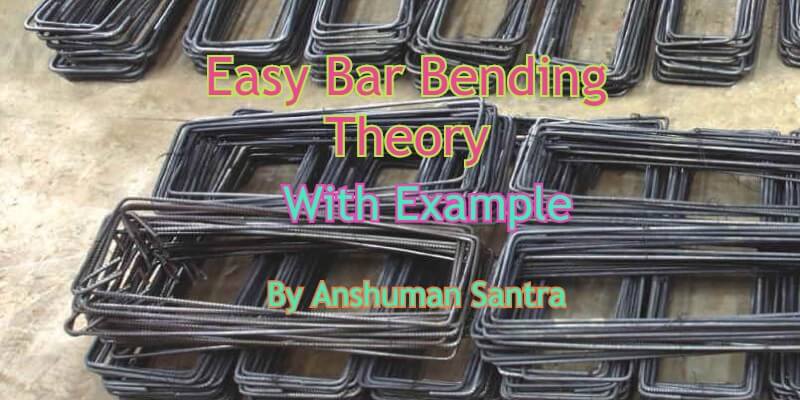Easy Bar Bending Theory
Describing Easy Bar Bending Schedule by Anshuman Santra
1. Lap Length or Lap Splices

We are going to share with you Easy Bar Bending Schedule in a very effective way with a practical example. During Placing the steel for R.C. Structure we need to make a Bar Bending Schedule for easily place reinforcement and quantity calculations,
At the time of making Bar Bending Schedule, if the required length of bar is not available then lapping i.e. placing 2 nos of bars side by side for a designed length is done. This designed length is the development length.
For ordinary concrete 1:2:4 nominal mix, the lap length for tension with plain grade – 1 M.S. Bar and below is the development length 58d including anchorage value.
So excluding anchorage the lap length = 5-k x 9d
=58-2 x 9d
=40d
Where, 9d is the value for hook allowance for bar up to 25mm with a value of k=2.
For HYSD bars the lap length with 1:2:4 concrete is 68d including anchorage.
So excluding anchorage the lap length = 68-2 x13d
= 42d
Where 13d is the hook allowance for deformed bars up to 25 mm dia.
For calculating development length for compression bar k=4 taken.
*The straight length of the lap shall not be less than 15d or 20 cm
2. End Anchorage
An anchorage is generally provided in the form of..

In the Bar Bending Schedule the hook or bend allowance depends on the grade of the steel governed by the value of the constant k. The value of k is taken as 2 for ordinary mild steel (190 N/mm2)
k is taken as 3. In the case of cold twisted bars k is taken as 4.
In the case of bars above 25 mm dia it is desirable to increase the value of k to 3, 4 and 6 respectively.
For a plain mild steel bar, the bond resistance value of an anchorage is assumed as 16d for semicircular hook, 8d for 90° bend hook and 12d for 45° bend hook.
The Length of the straight portion of the bar beyond the end of the curve is 4d.
*The best form is semicircular hook as this has greatest bond resistance value.
* In case of deformed bars , the value of bond stress for various grades of concrete is grater than 40% than the plain bars so deformed bars may be used without hook and anchorage provided.
According to I.S : 2502-1962
* Hook allowance shall be taken as, 9d, 11d, 13,d and 17d for k values 2,3,4 and 6 respectively and rounded off to the nearest of 5 mm, but not less than 75 mm.
For 90° bend allowance shall be taken as 5d, 5.5d, 6d, and 7d for k values 2,3,4 and 6 respectively and rounded off to the nearest of 5m, but not less than 75 mm.
3. Bent up Bars

The usual practice of bending of a bar near support is at an angle of 45° . The angle of bend may also be 30° in shallow beams where effective depth is less than 1.5 times its breadth.
The purpose of bend near a support is two fold, Firstly to resist bending moment which occurs at the region of the support and secondly to resist share force which is greater at the support.
However, when the position of bent up bars are not shown in the drawing but its required to prepare a schedule then the position of crank may be considered as ¼ th to 1/5th of the effective span of beam.
*If a bar is cranked at both ends at 45° then total length of the bar= L+2X0.42d
*If a bar is cranked at both ends at 30° then total length of the bar= L+2×0.27d
Example
Problem: A R.C.C. (1:2:4) rectangular beam 20 cm wide x 20 cm deep x 3.0 m , overall length is reinforced with tor steel bar 3 nos. 16 mm dia (wt- 1.58 kg / m) two outer bar straight and 1 hooked at ends and the inner bar bent up at 45° at appropriate places with L-hooked at ends. At top two outer hanger bar are 10 mm dia (wt -0.62 kg/m) straight and I-hooked at ends. Stirrups are 6 mm in dia M.S. bar (wt- 0.22 kg/m) and spaced at 20 cm c/c.
All concrete cover =2.5 cm
1) Draw a drawing to show bar bending arrangements for the beam.
2) Show the appropriate method of entering the measurements in the column of a measurement Book (MB) and prepare a Bill of Quantities for four such beam.

Solution:

Also you can check..
[PDF] Download A Textbook of Fluid Mechanics & Hydraulic Machines By R K Bansal
Download Strength of Material Book by Ramamrutham
Download PDF of Surveying and Leveling vol. I and II by B.C. Punmia
Download Concrete technology theory and practice by M.S. Shetty
Download Surveying and Leveling book By N.N. Basak
Polytechnic/ Diploma Semester Wise E-Book for Civil Engineering
Download Building Materials book By S. K. Duggal
[PDF] Download Text Book of Engineering Drawing
How can we conserve water in our homes
Download Civil Engineering Objective Type questions Written by S.S. Bhavikatti




